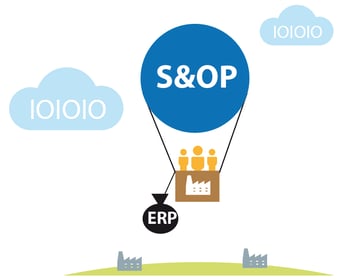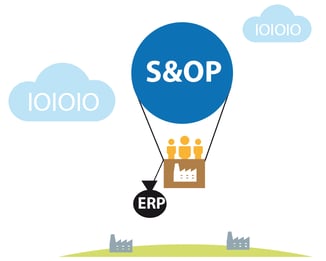Is Your ERP Hurting Your Sales and Operations Planning?
Jesse Kelber - December 03, 2019

 Is your ERP working for you? Or against you? Sometimes businesses can get so entrenched in “how we’ve always done things” that they don’t see how the old ways are actually hindering their forward progress. And when it comes to a smoothly functioning sales & operations planning (S&OP) process, this hinderance can become fatal. S&OP is a constantly evolving, cross-departmental, high-level set of processes that are deeply entwined in and around multiple business units. It focuses on developing a future outlook, using historical data as its source material. Being locked into an archaic ERP system can throw up a brick wall in front of that future vision. To be sure we’re all on the same page as we get started, here are brief summaries of the major terms we’re working with today, ERP and S&OP.
Is your ERP working for you? Or against you? Sometimes businesses can get so entrenched in “how we’ve always done things” that they don’t see how the old ways are actually hindering their forward progress. And when it comes to a smoothly functioning sales & operations planning (S&OP) process, this hinderance can become fatal. S&OP is a constantly evolving, cross-departmental, high-level set of processes that are deeply entwined in and around multiple business units. It focuses on developing a future outlook, using historical data as its source material. Being locked into an archaic ERP system can throw up a brick wall in front of that future vision. To be sure we’re all on the same page as we get started, here are brief summaries of the major terms we’re working with today, ERP and S&OP.
Enterprise resource planning, or ERP: A suite of business software tools used to collect, store, and analyze data coming in from multiple departments and business units. It is non-industry-specific, meaning the same ERP solution may be used by nearly any company, of any size, no matter the sector. That also means that there are some ERP solutions designed for certain industries that might not work so well in others. The idea of ERP began as an offshoot of financial software, so the focus has always been on current spending trends in relation to existing budgets, rather than extended forecasting and predictive analysis.
Sales and operations planning, or S&OP: Management-level processes that generate production, sales, inventory, logistics, and customer service plans. Used primarily in manufacturing, there is a definite slant to the process toward working with an existing supply chain and using that to flavor the forecasts developed. This industry focus has broadened in recent years as other sectors see the power of a solid S&OP process and implement some version to suit their needs. The timeframe focus is generally between one month and one quarter in the future. Forecasts are based on data generated by existing systems, often including the ERP suite a business has in place.
Traditional ERP Systems: The All-Inclusiveness Can Create Silos
With that lineage going back to financial software, traditional ERP solutions tend to be rigid in format and all-inclusive in nature. This means a couple of things when it comes to how these systems will interact with an S&OP project. First, the inherent rigidity means that there is often no way to adjust the output data to meet the needs of a predictive process like S&OP. The ERP system spits out data on company-wide budgeting and if you can make use of that to inform your forecasts, great. If not, you’re left to find alternative sources for the data you need. Adopting a postmodern ERP mindset can help free you from this by letting you implement a different system, running alongside your existing ERP if necessary, that takes the information from that ERP and converts it into something your S&OP process can indeed use.
Unfortunately, data sharing is not a strong suit of most ERP systems, largely due to their having been designed as one-stop-shops for all things business planning.This means they were not designed to play well with other systems or solutions. Along with the data output issue mentioned above, this situation often leads to siloed information. For an S&OP process to work smoothly, it has to have access to data from a cross-section of business units. Further complicating things, that cross-section may change from one quarter to another as the business pivots with seasonal demand fluctuations or other variables. Having dedicated tools for each leg of the supply chain lets each team set their own goals and processes, which when well documented provides the access necessary to tear down those silos and enables the creation of the accurate forecasts you need.
Data Integrity Is Crucial
S&OP, perhaps more than any other supply chain process, relies on accurate data from reliable sources. If you’re working with an outdated ERP, or if not every team involved has the access they need or the workforce to keep up their end of the bargain, your S&OP will suffer. With systems in place dedicated to generating reliable data on each stage of your supply chain, the accuracy of forecasts generated by your S&OP process will improve dramatically. Additionally, dedicated supply chain management systems come with their own baked-in checks and balances, meaning they can patrol their own data integrity and alert you to any discrepancies before they can cause disruptions.
S&OP Is a Flexible, Future-Facing Process. Can Your ERP Keep Up?
When it comes to two business solutions that should be able to get along, yet quite often seem completely incompatible, you won’t find a better example than S&OP and ERP. That does not mean, however, that you’re doomed to lackluster forecasts and wonky data leading to unrealistic predictions. S&OP is an inherently flexible process. It has to be—after all, there are so many unknowns when you look into the future. To be able to accurately predict something like customer buying patterns requires both concrete facts and a sense of what disruptions are likely. It’s in that gray area that the relationship with ERP systems comes in. ERP may be a rigid, staid, and often completely inflexible set of processes—however, they can often provide exactly the concrete data needed to begin powering a winning S&OP operation.
The combination of ERP’s focus on the here-and-now and S&OP’s rosy outlook on the future can be precisely what you need for the most accurate sales predictions you’ve ever seen. Or it can end in tears. The trick is in knowing your systems, making the necessary adjustments (whether that means using what you’ve got or implementing something else), and understanding that most businesses don’t fix something unless it can be shown to be detrimental to ROI and/or the bottom line. Adopting a postmodern ERP mindset is the key to making the most of what you’ve been given, or the first step to collecting the information you need to back up your need for a better solution. Either way, S&OP is the way forward. And if your ERP is causing issues, it may be time to look for a fix.
LATEST POSTS
- Understand Circular Economy in The Manufacturing Industry
- How Can Industry 4.0 IT Integration Be Achieved Smoothly?
- The Significance of Order Sequencing in Discrete Manufacturing
- How to improve your Supply Chain Management: The Power of Control Towers
- Optimizing Human Resource Scheduling in Manufacturing: A Technological Approach



